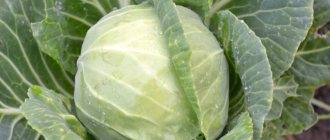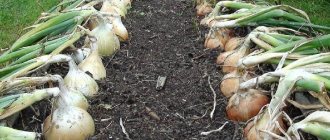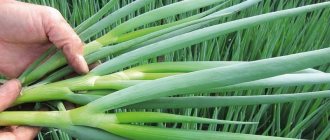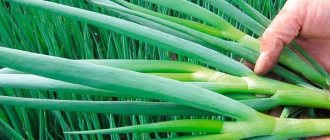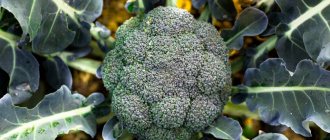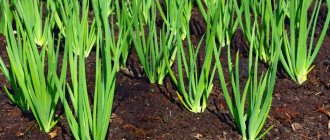A relatively new and quite interesting cabbage, the demand for which is increasing every year, is kale cabbage. This cabbage also has other names - curly cabbage, Grunkol cabbage, Bruncol cabbage, Brauncol cabbage - Brassica oleracea var. sabellica. Kale is a variety of the well-known cabbage and belongs to the Cruciferous family.
Kale leaves of various varieties. © Burpee
Kale is considered a leafy cabbage because it does not form a typical head. Cabbage leaves are similar to lettuce leaves, only more wavy and can be colored blue, red, green and even purple. Botanists often compare kale cabbage with wild cabbage, but its true origin has not been precisely established, although there is very reliable information that kale cabbage was already quite widespread in the Middle Ages.
The truly massive distribution of kale cabbage began only in the 19th century; around this period, cabbage came to our country, but then it did not become widespread, and only a century later they began to be interested in it in our country. However, we still do not have real industrial plantations, which cannot be said about countries such as Holland, Japan and Turkey, where this cabbage is actively consumed.
Today we will try to talk in detail about the agricultural technology of this cabbage, talk about its beneficial properties and list several common varieties.
Ways to grow kale
There are two options for growing kale cabbage - sowing seeds directly into the ground and through seedlings.
1. Growing kale in open ground
The first method is used quite often, because kale does not tolerate transplantation very well, but this method is acceptable only in the southern regions. Seeds are usually sown in early May, deepening them 1-2 centimeters into the soil.
2. Growing kale through seedlings
In cooler regions, it is better to grow kale through seedlings, and in order not to replant it or pick it, it is advisable to sow the seeds directly into peat-humus cups. Considering the rather slow development of kale cabbage at the initial stage, seeds should be sown in cups approximately 45-50 days before planting in the ground, and given the optimal time for planting in beds - early to mid-May - seeds should be sown for seedlings in late March - early April.
If you are confident in the quality of kale seeds, then you can sow them one at a time in each cup, but if you doubt their germination, then it is better to sow two or even three seeds, and then remove weak seedlings or try to transplant them into other cups, if the seedlings will develop equally.
To increase the germination of seeds and the speed of germination, before sowing in the ground, they should be placed (for about a quarter of an hour) in water heated to 40 degrees, then dipped in cold water for ten minutes. After this, the kale seeds must be placed in a damp piece of gauze and left there for a couple of days, keeping the fabric moist. During this period, the seeds may hatch and can then be sown in the ground.
By the way, about the soil: the optimal one for sowing seeds is a mixture of garden soil, river sand and humus. At the same time, one part of humus and garden soil requires five parts of river sand. If there are doubts about the safety of the soil, then the prepared and thoroughly mixed substrate can be treated with boiling water or calcined in the oven at a temperature of 70-80 degrees for half an hour.
Sowing kale cabbage seeds into the ground is carried out in pre-made and moistened holes about one and a half centimeters deep with a distance between them of 2-3 cm when sowing in peat-humus pots, and 4-5 cm when sowing in boxes. After placing the seeds in the holes, they must be sprinkled with fresh soil and lightly compacted. Next, you need to cover the containers with seeds with cling film (if these are cups, then they can be placed in a box with high sides), and maintaining soil moisture at the optimal level (without waterlogging or drying it out), monitor the appearance of seedlings on the soil surface. As soon as they appear, the film must be removed.
As soon as the cabbage shoots appear, the box or cups should be placed on a southern windowsill and the room temperature should be maintained at 22-23 degrees Celsius. Seedlings require eight hours of daylight, moderate soil moisture, fresh air (but no draft!) and periodic loosening of the soil surface to prevent the formation of a soil crust.
Kale cabbage seedlings. © Bethany
Seed selection
When purchasing Kale cabbage seeds in a store, you should carefully study the information on their packages. Particular attention is paid to the appearance and size of the bushes. Depending on the variety, the height of Kale cabbage varies from 50 cm to 1.5 m.
To understand how many seeds you need to purchase, it is enough to correlate the volume of future bushes of the selected variety with the size of the area allocated for planting cabbage.
The appearance of cabbage is determined by the shape and color of its leaves. Red and purple are high in phytonutrients and are considered healthier than green leafy varieties. Green Kale is the most cold-resistant and some of its varieties can withstand temporary cold temperatures down to -15°C. The shape of the leaves plays a role only if it is grown for decorative purposes; the curling of the foliage does not affect the taste and nutritional properties.
The ripening period, depending on the variety, can vary from 40 to 80 days or more.
When to plant kale seedlings
Picking, as we indicated above, is better not to do, but to sow the seeds in peat cups or directly into the ground, however, if sowing was carried out in boxes or other containers, then picking should be done when the seedlings form a pair of true leaves, and this must be done with lump of earth. Usually, a teaspoon is used for picking; it is used to pry up the cabbage with a lump of earth, after moistening the soil, and transplant it into separate containers, into depressions in the ground previously prepared for planting.
Landing place
- To grow this attractive plant and get a generous harvest, you need to choose an open and sunny area . Partial shade is completely acceptable.
- Only fertile and nutritious soil with a slightly acidic pH is suitable.
- The best predecessors in the garden will be nightshades (tomatoes, potatoes), legumes, and cucumbers.
- When preparing a site organic matter (compost, humus) in the fall, half a bucket per 1 square meter. add mineral fertilizers to the soil in the spring.
user ID 127071 on pixabay / Personal archive
When to transplant kale to a permanent location?
Transplantation into open ground or a greenhouse should be carried out when the seedlings form two pairs of true leaves and stretch 9-11 centimeters, usually this happens after 45-50 days, as we discussed above.
Planting in a permanent place should be carried out in early to mid-May (depending on the weather) and placed in holes sufficient to accommodate a clod of earth with roots or a peat-humus glass in the holes, with a distance between plants of approximately 35 cm and between rows - half a meter. When planting kale in holes, it is advisable to add 50-100 g of wood ash and the same amount of humus, thoroughly mixing the soil and moistening it. Seedlings should be buried in the soil until the first true leaves, after which the soil should be compacted, pressed with fingers and watered (0.3-0.5 liters per plant).
Sowing in open ground
Kale cabbage is quite frost-resistant. In order for the seeds of this crop to germinate, it is enough for the air temperature to be within 5°C, however, there must be plenty of light.
Before sowing the seeds, the soil is dug up and fertilized with ash, humus and universal mineral fertilizer, for example, nitrophoska. The bed is made slightly raised. The seed sowing pattern is the same as when planting seedlings - 30x50. In each hole, 3 to 5 pre-sprouted seeds are placed at a depth of 1.5-2 cm so that they do not come into contact with each other and covered with earth. Then the bed is watered and covered with film. To prevent the film from being torn off by strong winds, it must be well secured at the edges using fastening pins or any available material.
After about a week, shoots appear and the film is removed. It is important not to miss this moment, since young plants left under the film can burn in the bright spring sun. At the same time, the seedlings are thinned out, leaving one of the strongest specimens in each hole. If two strong plants have sprouted in one hole, one of them will still have to be removed - they will not be able to fully develop together and they are also unlikely to survive transplantation to another place.
Kale requires plenty of regular watering, especially on hot days. In order for the root system of plants to receive the maximum amount of moisture, small grooves are formed around the bushes, which will not allow water to spread over the bed during each watering. To keep the soil constantly slightly moist, the soil can be mulched using compost or humus. This procedure will also help eliminate the need for frequent weeding.
In the rows and directly around the bushes, the soil is carefully loosened, since the crop is very demanding on the air permeability of the soil.
Plants are first earthed when they reach a height of 20 cm. During this same period, all weak and thin leaves are removed so that they do not interfere with the formation of new healthy ones.
Fertilizers should be applied no earlier than a month after planting seedlings or planting seeds in open ground. The solution should be slightly concentrated.
If the soil on which cabbage is grown is fertile, it is not recommended to feed the plants more than once every 6 weeks. If less nutritious soil was used for planting, fertilizing is carried out once a month.
It is best to alternate mineral and organic fertilizers. Liquid compost is often used as organic matter, and when choosing mineral fertilizers, preference is given to those whose composition is dominated by nitrogen and potassium.
Fertilizers are applied only to well-moistened soil, otherwise the cabbage horse system will receive a chemical burn and fertilizing will do more harm than good.
The best place to grow kale
The place must be well lit and free from shadows. In the same place, this cabbage can be grown for three seasons in a row, and if in the autumn, when you cut the stem, you leave 2-3 cm from it growing in the soil, then the next season, if the remaining part of the plant overwinters, It is quite possible to get an early harvest of this cabbage.
As for predecessors, the best are all nightshade crops, pumpkins and, of course, legumes, but the worst predecessors are, naturally, cruciferous crops.
Advantages of the plant
- Gardeners try not only to grow a healthy vitamin product, but also to decorate the area with kale, since outwardly the plant looks very decorative.
- The most remarkable thing is that despite its exotic appearance, kale is an unpretentious plant that does not require special care.
- Another quality that attracts people in this plant is cold resistance . I read that kale can withstand quite significant temperature drops down to -10°C below zero. What makes this type of cabbage the most valuable? Especially in the autumn and spring periods, when abnormal cold comes unexpectedly. It can be kept in a greenhouse until winter and can be planted there in early spring .
naturalflow/Flickr.com
Dwight Sipler / Flickr.com
Kale cabbage requirements for soil
The plant is very demanding of the soil; it must be fertile and not clayey or sandy - on such soils it will not even be possible to obtain a normal harvest. The soil must be air- and water-permeable, because kale does not tolerate stagnant water, especially in the root area, when the roots can simply rot. The soil pH level should be at 6-7 units.
The soil for planting kale cabbage seedlings, as well as for sowing seeds, must be prepared in the autumn; to do this, you need to dig it up with a shovel full, trying to remove all weeds. In spring, as soon as the soil is ready for working with it, the soil must be enriched with humus and nitroammophos. You need about a kilogram of humus per square meter of soil, and a tablespoon of nitroammophoska for the same area (applied for digging).
Kale cabbage seedlings planted in the ground. © Ericar
Kale calorie content, chemical composition
The description of Kale cabbage looks incomplete if you do not analyze its calorie content and the composition of its constituent substances. The vegetable contains many vitamins and mineral elements. Vitamin composition:
- A (retinol, retinoids);
- C (ascorbic acid);
- group B (thiamine, riboflavin, choline, pantothenic and folic acids, pyridoxine);
- K (phylloquinone);
- E (alpha tocopherol);
- PP (nicotinic acid).
Minerals:
- magnesium;
- calcium (interestingly, milk is inferior in quantity and speed of absorption of this element to cabbage leaves);
- potassium;
- copper;
- iron;
- phosphorus;
- zinc;
- sodium;
- selenium;
- manganese.
Kale is saturated with zeaxanthin and lutein, due to which ultraviolet radiation causes less damage to the eyes. The presence of indole-3-carbinol (a biologically active phytochemical) in the plant helps the vegetable fight cancer cells. Sulforaphane, an organic vegetative substance found in Kale leaves, has anticancer and antibacterial properties.
The plant contains easily digestible protein. Kale varieties easily replace meat foods, which is why vegetarians and raw foodists love the vegetable.
The vegetable contains polyunsaturated fatty acids - Omega-3. The characteristics of the plant include an analysis of nutritional value. The valuable composition of the vegetable does not prevent it from having a low calorie content. The nutritional value of the plant is characterized by the following indicators (per hundred grams):
- calories - fifty;
- fat – a little more than half a gram;
- proteins – three grams (half the daily requirement);
- carbohydrates – eight grams;
- water - more than eighty grams;
- dietary fiber – two grams;
- ash - one and a half grams.
How to feed kale?
Feeding can be done every 20-25 days. The first time you can feed kale cabbage is during the period of active leaf growth; during this period, the best fertilizer is fermented weeds. To obtain high-quality and safe fertilizer, you need to fill the barrel a quarter with weeds and fill it with water. The optimal ratio of water and plant mass is 10 to 1, respectively. It’s great if you have chicken droppings, you can add it to the composition at the rate of a kilogram of droppings per 100 liters of solution. Fertilizer is usually “prepared” from 10 to 20 days (if it’s hot, then faster, if it’s cold, slower). You can usually tell that a fertilizer is ready for use by the foam on the surface, or more precisely by its absence: as soon as new foam stops forming, the fertilizer needs to be diluted twice with water and can be used by watering kale cabbage with it strictly at the root at the rate of 0.5 liters per plant .
Kale cabbage in open ground. © Fred and Mary
Description of the variety
Kale is one of the most interesting and useful cultivated plants for humans. This cabbage is unpretentious and is also capable of producing rich harvests in almost any climatic conditions. In addition, the crop also has a high decorative value, so it can successfully complement a variety of plantings in small summer cottages.
Characteristics of the variety
This plant is a biennial herbaceous variety of cabbage used for food and also for feed purposes. It belongs to the large Cruciferous family, so Kale is genetically the closest relative of traditional cabbage varieties. The main distinguishing feature of the variety is the absence of a branched stem: instead, the entire above-ground part is occupied by a ground leaf rosette, assembled from large leaves.
Find out what to do if your cauliflower blooms.
The root system of Kale is tap-type, with a powerful axial root and numerous thin lateral branches. A small rounded stem emerges from it, but in some varieties it can reach about 50–100 cm in length. Like all members of the family, the plant blooms in the second year of the growing season; at this time, numerous flowers develop on the bush, collected in characteristic inflorescences. The yield of the variety is high; from 1 m² it is often possible to collect from 3 to 6 kg of products.
There are several varieties of Kale:
- Curly - has figured leaves that are particularly decorative;
- Red F1 — the plant is decorated with dark red foliage;
- Siberian — the variety is highly resistant to frost and sudden changes in weather conditions;
- Cane - characterized by an elongated stem, the leaves are located on the apical rosette;
- Dino - especially popular due to its elongated graceful leaves;
- Premier — an ultra-early ripening variety that can be grown in open ground even in northern climates;
- Tuscan Cale (Black Tuscany) - has rich green-blue leaves, distinguished by a pimpled structure. This is the most popular variety, which is successfully grown by the Russian gardening school;
- Scarlet - green-purple winter-hardy cabbage, up to 1 meter high.
Taste qualities of Kale: the crop is characterized by a special delicate structure and moderately rich taste. When fresh, the leaves are dense and crispy, after heat treatment they are soft and tender. The pulp is juicy and sweet, with a distinct cabbage flavor and aftertaste; it is not inherently spicy. Once frozen, the sweetness and cabbage flavor increase dramatically. Young leaves are not inherently bitter, but overripe leaves may have a noticeable bitterness.
Variety selection
Curly cabbage has been known to man for several millennia. As historical artifacts indicate, this name for the fruit plant existed back in the days of Hellenistic Greece, where it played a key role in agriculture as a universal food and feed crop. The plant appeared on the territory of Europe in the Middle Ages, after which its full cultivation began.
Did you know? In Australia, Kale is a traditional ornamental plant; varieties with bright red and purple leaves are used for landscaping urban landscapes and garden plots.
Modern varieties of the vegetable appeared in the second half of the twentieth century. At this time, new highly productive varieties of Kale were developed, the active development and improvement of which continues today.
Description of the fruit
As such, the variety does not have fruit. Numerous leaves developing from a common leaf rosette are considered valuable for food and feed purposes. Depending on the hybrid, their length varies from 10–20 to 50–100 cm, and their width from 5 to 15 cm. They are characterized by strong dissection of the edges with all kinds of curls, up to separation into separate parts. However, there are also smooth-leaved forms.
The base of the leaf is a soft leaf stem, to which individual small branches are attached. This creates a special curly structure, which gives the plant excellent decorative properties. The veins on the leaf are convex and highly branched. The color of the leaves is varied, from rich green shades to burgundy-red and purple tones.
Benefits and harm to the body
Kale cabbage is one of the most valuable plants used by humans for food. It is low in calories, but at the same time has a fairly high nutritional value, which is the best way to create a comprehensive and healthy diet. The leaves contain valuable amino acids and proteins, which makes it possible to replace meat in all kinds of diets.
Important! If you have any food allergies, the introduction of Kale into your daily diet should only be done after consultation with a doctor.
The vegetable contains a huge amount of vitamins, rare minerals and antioxidants, the active interaction of which can:
- normalize and improve the functioning of the digestive tract;
- restore the functioning of the visual organs;
- improve blood structure, including coagulation;
- supply the body with easily accessible forms of calcium;
- inhibit pathogenic microflora in the body;
- stimulate the immune system;
- protect organs and tissues against the development of cancer.
However, frequent consumption of cabbage can have a negative effect on the body. Like other green vegetables, kale should be included in your diet in moderation. If consumed daily, the product may cause digestive upset, especially in the case of acute and chronic forms of flatulence and bloating. In addition, contraindications for consuming such greens are all kinds of formations in the kidneys and gall bladder.
Pests on kale cabbage and control measures
If agricultural practices and crop rotation are followed, kale cabbage is rarely affected by pests, however, in years when the weather is favorable for the active reproduction of pests and there are a lot of them, kale cabbage can be affected by cabbage aphids, various weevils and cutworms, cabbage whites and moths, cabbage fly, cruciferous flea beetle, rapeseed flower beetle, sawfly and slugs.
You can fight pests with folk remedies; they usually work well. So, for example, you can protect yourself from pests and diseases (mainly rot and other “cabbage” diseases) by dusting plants with wood ash or tobacco dust; it is also permissible to mix tobacco dust and wood ash together and dust cabbage with this mixture. The advantages of this mixture are obvious - it is effective and safe, but there are also disadvantages - this is the instability of the mixture to moisture: after rain or sprinkling, the plants will have to be powdered again.
A little more effective is treating kale plants with vinegar; for this, 7% vinegar is usually used; it must be mixed with water and added to the composition with 150 g of chicken manure per 10 liters of water, after which the composition must steep for a couple of days.
Onion peels, which have phytoncidal properties and increase plant immunity, help to cope with diseases and pests of kale cabbage. Usually, for 500 g of onion peel you need three liters of boiling water, pour the peel over it and let it brew for a couple of days, then filter, add an “adhesive” in the form of a tablespoon of any shampoo or half a bar of laundry soap and treat the plants once a week until signs of disease completely disappear or pests.
As for slugs, they can be controlled by removing them manually at night or by laying cardboard, slate sheets, plywood and similar materials over the soil surface. Slugs accumulate under these “shelters” and can subsequently be destroyed.
Of course, in addition to folk remedies, you can use insecticides (against pests) and fungicides (against fungal diseases) in strict accordance with the instructions on the packaging and only those that are approved for use in the current season. It is appropriate to use them when the situation is serious and the plant is in danger of being completely destroyed.
Features of collection and storage
If all requirements are met, Kale can bear fruit throughout the summer and the first half of autumn. This makes it possible to enjoy the aromatic vegetable throughout the growing season and successfully prepare it for the winter. Harvesting should be approached no less carefully than caring for the beds.
To do this you need:
- pluck leaves no more than 30–40 cm long; larger ones lose their aroma and tenderness;
- inspect the beds daily, as the leaves grow unevenly;
- cut no more than 2-3 leaves from 1 bush; excessively intensive harvesting of greenery can cause plant death;
- start collecting only after the average height of the plants exceeds 20 cm;
- After fertilizing, wait at least 1 week before harvesting; this will help avoid high concentrations of nitrates in the green mass.
The harvested crop should be immediately moved to the refrigerator; even just a few hours of leaving the leaves in the heat can lead to their instant wilting. In the refrigerator, cabbage is stored in individual plastic bags or in cling film.
In this form, at a temperature of 0...+5°C, they are able to maintain their freshness for 1–3 weeks. If you want to stock up on cabbage for the entire winter, freezing it in the freezer is ideal. It perfectly preserves the structure of the leaves and their taste for several months.
When to harvest and how to store kale
Typically, cabbage harvesting begins three months after emergence when sowing seeds in the ground (in a garden bed) or two months after planting seedlings when growing kale through seedlings. As soon as the plant reaches a height of 18-22 cm, you can start cutting the leaves. Leaves need to be cut off gradually as they grow; you shouldn’t wait until many leaves grow back; over time, they become very hard and acquire a bitter taste. It is advisable to cut the leaves of kale cabbage at a height of five centimeters from the soil surface, this will allow the plant to form new leaves.
The harvested kale cabbage in the form of leaves is best consumed immediately, but can also be stored for 5-6 days in the freezer. Gourmets note that leaves left in the freezer for this period of time taste even better.
Pros and cons of the variety
- The main beneficial properties of the vegetable:
- high productivity;
- excellent taste properties;
- frost resistance;
- unpretentiousness to growing conditions;
- short growing season;
- high decorative value of bushes.
- Kale is not without its shortcomings:
- it is susceptible to many characteristic pests and infections of the crop;
- bushes require timely harvesting, otherwise the taste characteristics are sharply reduced;
- the plant does not reproduce seed during the first generation.
The benefits and harms of kale cabbage
By the way, about taste: kale is not only tasty, but also healthy , it contains minerals and proteins, a large amount of vitamins, fiber, fatty acids and amino acids, including essential ones. At the same time, cabbage is dietary, and you cannot gain weight by eating it.
Kale should be consumed by people with calcium deficiency, during periods of high stress, overweight, and to strengthen the immune system.
It is not advisable to eat kale for people with diseases of the gastrointestinal tract, dysbacteriosis and disorders of the endocrine system.
Kale cabbage. © Danita Delimont
Useful properties of the vegetable
The nutritional value of kale cabbage is very high. In addition to the standard set of vitamins A, group B and C, it contains many micro- and macroelements, such as calcium, magnesium, phosphorus, zinc, iron, selenium, etc.
Attention! There is more calcium in kale than in cow's milk.
Openwork leaves are useful for vegetarians, as they contain a lot of protein. Kale contains 9 essential and 18 non-essential amino acids, including Omega-3. This vegetable is recommended for those who want to lose weight, because its calorie content is 28 kcal/100 g of product.
Doctors and nutritionists advise including kale in the diet if you have a weakened immune system, eye diseases, or vitamin deficiency. Regular consumption of leaves helps cleanse blood vessels of cholesterol and prevents the development of cancer cells. The vegetable helps fight body intoxication thanks to the antioxidants it contains.
Kale salad

